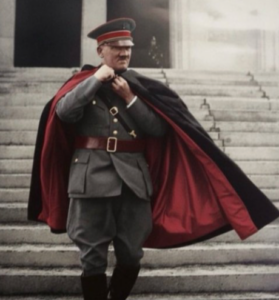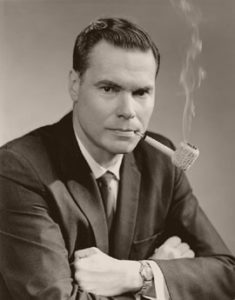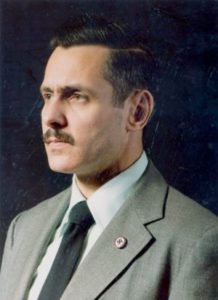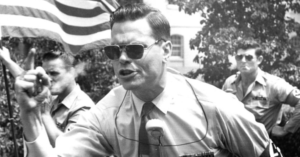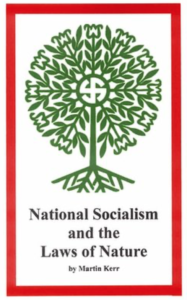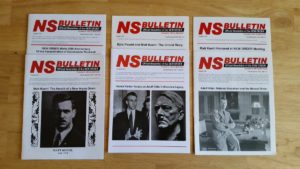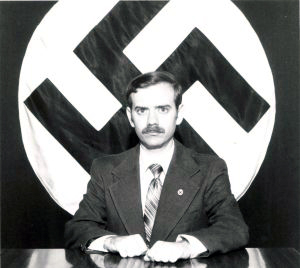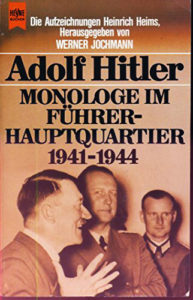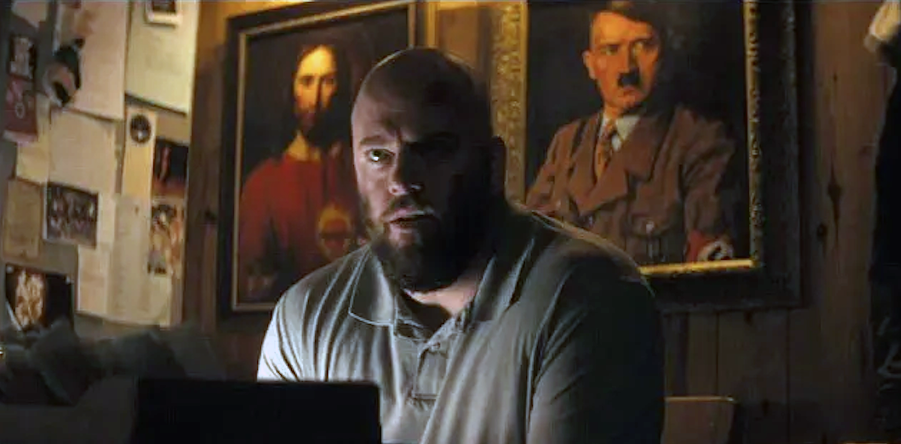Rockwell as Conservative
by Gregory Hood (pic below)
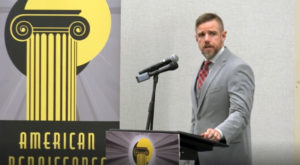 Emphasis in bold & red added
Emphasis in bold & red added
by Ed.; endnotes omitted:
The Left usually understands the Right better than the Right understands itself. In the dominant progressive narrative, conservatives are simply more “respectable” racists that use rhetoric about anti-Communism, free markets, or limited government to disguise their bias. They may not even be aware of it, but American conservatism is, in this telling, an inherently racist ideology.
Commander George Lincoln Rockwell in many ways shared this analysis. His National Socialism was not an ideology so much as a tactic, an attempt to build a fighting conservatism capable of defeating the militant Left. Rather than Nietzsche, Baron Evola, or even Alfred Rosenberg, the greatest influences on George Lincoln Rockwell were Senator Joe McCarthy, Douglas MacArthur, and even William F. Buckley.
His inability to rally the American Right marks a milestone in white political activism, as George Lincoln Rockwell is the bridge between patriotic racial conservatism and revolutionary White Nationalism. Commander Rockwell was above all a tactician, but he failed to reveal some new method for white patriots to achieve political power. Instead, his strategic importance is that he demonstrated, perhaps inadvertently, the bankruptcy of American conservatism. Rockwell’s hope for “street fighters of the American conservative movement” was always doomed to fail. One does not need to be a “Nazi” to see that conservatism is designed to lose, not to fight.
George Lincoln Rockwell began his turn to the Right at Brown University, where he dissented against the “blank slate” teachings he encountered in his sociology class. He notes in his autobiography This Time the World, that he was always in conflict with the “liberalism” overflowing at Brown, which he would later connect to Communism. He made the same connection between the “filthy thing” and the chaos and ugliness of modern art that he experienced in his studies after World War II. It’s not surprising in the intense Cold War atmosphere of postwar America that the young naval officer would link cultural degradation to the struggle against the Soviet Union.
Commander Rockwell’s first political activism was on behalf of General Douglas MacArthur, who was fired by President Harry Truman because of his willingness to expand the Korean War into “Red” China. General MacArthur would receive a dedication in This Time the World, and Rockwell would adopt MacArthur’s habit of chewing on a corncob pipe. According to Rockwell, it was in the midst of his efforts to book a hall for General MacArthur that he was introduced to the Jewish question. Further research led him to conclude that Bolshevism had Jewish roots and that there was a preponderance of Jews among Communists in the United States. Thus, Rockwell’s opposition to Jews was rooted in his conviction that “Jewish traitors” were sabotaging the Cold War. However, this did not extend to questioning the American Establishment as a whole—when Commander Rockwell wanted to attend a speech by Gerald L. K. Smith, he first asked the local FBI office for permission.
In the early 1950s, Commander George Lincoln Rockwell served in Iceland, where he met his second wife and obsessively re-read Mein Kampf, as well as other works like the Protocols of the Learned Elders of Zion. He even took his new wife Thora on honeymoon to Berchtesgaden to visit Hitler’s mountain retreat. However, bizarrely, it was after the work of Adolf Hitler “stripped away the confusion” from his mind that Rockwell began his involvement with mainstream conservatism. He worked as an independent contractor for William F. Buckley and his National Review.
Commander Rockwell refers to William F. Buckley as “Bill” in This Time the World and notes that he is “square-dealing” as a man. This exaggerated familiarity explains the wildly different interpretation of Buckley’s character that men who knew him far more intimately have claimed, as in Peter Brimelow’s devastating obituary for him. Perhaps more importantly, even after becoming at least a philosophical “Nazi,” Rockwell says of Buckley that “There is more pulsating brain-power and genius surrounding Buckley than in any place else on earth, where I have ever been” and Buckley himself is “brighter than all the rest.”
After (by his own admission) failing to obtain many subscriptions for the magazine, Rockwell tried his hand at organizing “The American Federation of Conservative Organizations” and a newspaper to be called the “Conservative Times.” At this time, Rockwell believed that conservatives could “sneak up on the Jews” by rallying conservatives behind a militant (but publicly philo-Semitic) organization. Rockwell later mocked his own restrained approach and declared that liberals had to be fought using their own tactics—“force, terror, and power.” He was further disgusted by the “human content of the ‘right-wing’—ninety percent cowards, one-track minds, tightwads, and worst of all, hobbyists” that were unwilling to jeopardize their possessions.
Interestingly, however, Rockwell also credits the John Birch Society with “[doing] what I planned then” (This Time the World, 87). Jewish entertainer Bob Dylan would later mock the Society in “Talkin’ John Birch Paranoid Blues” wherein the paranoid narrator proclaims that the only “true American” is “George Lincoln Rockwell.” In his own way, Commander Rockwell confirmed Dylan’s intended smear by declaring a shared purpose between the John Birch Society and himself.
Nor was Rockwell alone on the “radical” Right in believing such a strategy could work. Revilo Oliver was a founding member of the Society and admitted that he continued to work for it even after all mention of Jews was eliminated. In the end, Oliver only abandoned the Society because of his contempt for Robert Welch, writing in America’s Decline: The Education of a Conservative that “one does not abandon a lost cause before one knows the cause was lost because the general is a traitor” (200). Like Oliver, Rockwell’s chief gripe with the Right wing was that the people involved were flawed and that the American Right was essentially cowardly. Instead, Rockwell would build a fighting faith of Nazism as the only “alternative to communism.”
Even so, Rockwell’s Nazism was still couched in conservative forms for years afterward. Rockwell worked for Russell Maguire of the American Mercury, later writing scathingly about Maguire as someone who was actively hurting the cause. However, as Andrew Hamilton has pointed out, Maguire may well have had good reason for his caution and in any event, was far better ideologically than the “brilliant” William F. Buckley.
Rockwell had fonder memories of his partnership with DeWest Hooker, and notes warmly that he wasn’t a “patriot or a right-winger or a conservative but a fighting, tough, all out Nazi.” Rockwell’s justification for this was Hooker’s creation of the Nationalist Youth League, which rallied “tough kids” in New York City to fight “Jewish Communism” and inspire them with “fanatical loyalty to the United States, the White Race, and Adolf Hitler” (100). Rockwell also quotes Hooker’s retelling of the Jewish role in bringing down Joe McCarthy’s crusade against “Jewish Communism.” Aside from the questionable background of Hooker highlighted by Andrew Hamilton, what is significant is that Rockwell identifies “Nazism” with a militant anti-Communist struggle that simply does not allow Jews.
George Lincoln Rockwell’s “coming out” was his protest to “Save IKE from the KIKES” along with Harold Arrowsmith in May 1958. This led to a minor media frenzy surrounding him after a synagogue was bombed in Atlanta a few months later, when it was revealed that Rockwell had corresponded with the bomber. Rockwell’s response was revealing. His writing shows that he thought that bombing a synagogue was a mistake “because it relates to the religious rather than political.” Rockwell’s focus on “atheist Jews” rather than religious Jews would be a constant of his later career, even while being interviewed in uniform standing in front of the swastika banner. Furthermore, Rockwell issued a statement that “I am anti-Zionist and anti-Communist Jews, and any other form of treason. I’m pro-American republic.”
Also at this time, Rockwell began printing literature for what he called the World Union of Free Enterprise National Socialists (WUFENS), which shows the Commander’s determination to fit National Socialism into the pro-free market mold of American conservatism. Rockwell denounced fascism as an economic doctrine of state ownership and promoted “international racism” as opposed to “racial nationalism.”
______ 卐 ______
Editor’s Note: As we will see at the end, this error, typical of American white nationalism (in contrast to Himmler’s Nordicism), cost the commander his life in 1967.
______ 卐 ______
Rockwell’s pro-Americanism was complemented by his vision of white unity between “Aryan” countries, a precursor to his later strategic contribution of “White Power.” However, Rockwell’s National “Socialism” largely neglected the economic aspects besides repeating general conservative themes. It is revealing that following the failure of WUFENS, Rockwell would create the American “Nazi” Party in 1959 instead of a “National Socialist Party.” Rockwell thus claimed the one term slur of “Nazi” for his own purposes, and said that it “means that we are racists.”
The American Nazi Party was notorious for its flamboyant use of street theater. The Commander had his critics on the Right, with members of the National States’ Rights Party charging that he was simply continuing his father’s “vaudeville” acts. Rockwell justified his tactics on the grounds that he needed to appeal to the masses with spectacle and easy to understand propaganda. Rockwell pointed out Jews on Wall Street funding the Bolshevik revolution, protested the film Exodus, and even staged activism against Sammy Davis Jr. With blacks, he was more creative, as he used “hate buses” to parody the so-called Freedom Riders, created “hatenanny” country songs, and in one notable instance, tried to enroll a monkey in a public school.
Lost in the debate over the appropriateness of the Commander’s tactics was the strategic purpose. In his speeches and writings, Rockwell blasted the “Communist-Negro” revolution, arguing that blacks were simply following the marching orders of their Jewish funders, with occasional independent blacks such as the Nation of Islam breaking free of Zionist control. Rockwell also appealed to spiritual idealism, proudly claiming himself and his followers as “fanatics” because only fanatics can truly create something. However, though Commander Rockwell bemoaned American civilization’s “unwholesomeness, love of money, and love of luxury” as a sign of decline, he rarely (if ever) turned his fire on the American economic or political system per se (William H. Schmaltz, Hate: George Lincoln Rockwell and the American Nazi Party [Washington, D.C.: Brassey’s, 1999], 212).
If anything, Commander Rockwell had a truly naive faith in certain institutions of the American government. From the time he asked permission from the FBI to attend a Gerald L. K. Smith rally, he kept the Bureau constantly informed of his activities, and even those of his members. According to Frederick Simonelli, author of American Fuehrer: George Lincoln Rockwell and the American Nazi Party (Urbana and Chicago: University of Illinois Press, 1999), Rockwell “believed—rightly or not—that the agency’s director, J. Edgar Hoover, secretly sympathized with most of his aims” (87).
During a meeting with Ed Fields, Rockwell went so far as to call the FBI while Fields was in the room. Though internal memos credited Rockwell with being “very cooperative with Agents,” it did the Commander no good. FBI reports on the ANP were scathing about Commander Rockwell as a person. More importantly, COINTELPRO specifically targeted the ANP for harassment, sending both Rockwell and his enemies fraudulent letters designed to sabotage the party’s operations. On one occasion, the FBI sent Rockwell a phony letter from a “supporter” designed to make him mistrust a subordinate. Fearing it violated federal law, an unknowing Rockwell promptly reported the letter—right back to the FBI.
The great strategic failure of George Lincoln Rockwell was the assumption that the vast majority of Americans (and especially conservatives) already agreed with him, but they were too cowardly to say so. In a 1965 interview, Rockwell said, “I think the majority of Americans think the same way I do, most of them don’t care to say so. Most of them are fed up with Negro pushing, they’re fed up with the Jewish-communists who have been time and again exposed as selling us out to the Soviet Union; they’re fed up with the cowardice of our administration. I think they’re grateful that we’re finally fighting in Viet Nam, but . . . I think we’ll lay down like we did in Korea and quit. In other words, I think the people are with me. They don’t like the name [Nazi] but they believe what I believe” (Hate, 251).
Campaigns against “peace creeps” were a staple of ANP activities. In November 1965, Commander Rockwell personally ripped a Viet Cong flag from a peace march and tore it to pieces. He recounted the incident with pride in White Power. At the same time this incident occurred, ANP members on the West Coast counter-protested peace marches with slogans like “Kill Reds in Vietnam” and “Peace Creeps Are Traitors.” Commander Rockwell’s slogan, “Not dead, not red, but dead reds!” was also a staple of his rhetoric. Even near the end of his career, Commander Rockwell bragged at campus speeches that he would launch a nuclear attack on Red China and claimed, “I’m going to be the man who pushes the button.”
In 1965, George Lincoln Rockwell ran for governor of Virginia. His platform was firmly focused on race and dismantling Jewish organizations. He advocated teaching “white supremacy” in the classrooms for an hour a day, deputizing white men to carry guns, and outlawing the Anti-Defamation League and the NAACP. Insofar as he spoke about economic concerns, Rockwell supported eliminating the income tax (Hate, 250). Rockwell’s focus on abolishing welfare for blacks, condemnation of the federal government, and promises to use the power of the state against Leftist radicals align naturally with the hard Right of the American conservative movement in the late 1960s and early 1970s. He only won a few thousand votes, as most of the segregationist supporters in the state broke for other third party candidates.
Though Rockwell was scathing in his treatment of “Right-wingers” and launched protests against Barry Goldwater, his writings reveal that he considered them somehow closer to his own positions than any alternative. In White Power in 1966, he bashes Barry Goldwater as the “Zionist-capitalist Jew ‘friend of the [Jewish] Captain’” engaged in a shell game with the “Red Jew labor leader” on the “other side.” He also has a detailed analysis of why “economic conservatives” cannot win, focusing mostly on tactical issues. He points out (accurately) that the masses will not vote for an economic conservative without the issue of race. However, these are essentially tactical criticisms, alternately criticizing conservatives as either being phony or tactically stupid.
In terms of ideology, Rockwell now praises fascism, using the Webster’s Collegiate Dictionary definition of fascism as “the movement towards nationalism and conservatism as opposed to internationalism and radicalism.” For Rockwell, race will be the glue that binds together a nationalism and conservatism that can win. Occasionally, Rockwell even made this explicit, with a forlorn hope that conservatives would rally behind him. The Rockwell Report and National Review exchanged barbs, which eventually led to a strange exchange of letters between Commander Rockwell and William F. Buckley. Rockwell challenged Buckley to convince him that he was actually doing harm; in response, Buckley dispatched a priest. During the meeting, Rockwell offered the American Nazi Party as the “street fighters of the American conservative movement” (Hate, 209). Needless to say, Buckley did not take up the Commander on his generous offer.
None of this is to say that Rockwell’s approach did not occasionally pay dividends. In August 1966, Commander Rockwell successfully rallied thousands of blue collar white Chicagoans to resist a desegregation effort led by Martin Luther King, Jr. After giving a well-received speech, Rockwell was showered with applause, as Chicagoans chanted “White Power” and waved the swastika. Overcome with emotion, “Rockwell was moved to tears” (Hate, 291). In September, he would lead a march through the streets of Chicago—though he had predicted 3,000 people, Rockwell’s “failure” still rallied 250 people to march under the swastika and slogan of “White Power.” Clearly, Buckley-style conservatism had nothing to say to blue collar whites fighting to defend their communities, and their rage and fear has only been vindicated by what Chicago has become today.
That said, Rockwell found that he could not capitalize on his tactical successes and that old style “Nazism” was unsuited to rallying white workers of Southern and Eastern European stock. This was an important factor in the transformation from the American Nazi Party to the National Socialist White People’s Party. The new ten points of the NSWPP also included nods to economics and social policy, although it was mentioned far after smashing “Jewish domination,” “Communism,” “Zionism,” “crime,” and “riots.” The ninth point stated “every productive, working American must have a decent job, life-time economic security and wholesome living conditions for himself and his family.”
Rockwell’s last major work, White Power, shows the Commander caught between Cold War conservatism and a more fully developed National Socialism. The opening of the book is a recitation of various outrages taken from the headlines, from sexual depravity to draft dodging. Most of these could have come from the pages of any conservative magazine of the time. Rockwell also gives an extended treatment to various charges of the Cold War American Right, detailing the “loss” of China to the Reds, the Marxist ties of Lee Harvey Oswald and the assassination of “our President” John F. Kennedy, and the government’s hesitation in fighting our “deadly Communist enemies” in Vietnam. In his famous “Nightmare” chapter, Rockwell posits a non-white takeover of America where the white police and armed forces are defeated with the help of international Communists from China and Cuba.
At the same time, White Power shows an important evolution in Rockwell’s thinking. Though Rockwell condemned Francis Parker Yockey’s work as a new form of “Strasserism” in 1964, in White Power he predicts an eventual alliance between white Russians and white Americans. Years before the Sino-Soviet split, Rockwell notes the alliance between anti-Soviet Trotskyites and the Red Chinese, Maoism being the preferred form of Communism for campus radicals and non-whites. Going further, Rockwell condemns the repeated “wars of racial suicide,” calling for a white racial unity in foreign policy that transcends even nationalism. This vision of race as the critical basis of identity, loyalty, and state policy, with nationalism as purely secondary, goes beyond anything Rockwell could have taken from German National Socialism. Furthermore, Rockwell writes, “The center of Jewish power and money is here in New York City, U.S.A., not Moscow and not even Jerusalem.”
By the time of White Power, Rockwell is also willing to criticize conservatives for substantive rather than tactical reasons. He goes so far as to say, “there are dozens of ‘socialistic’ operations in any decent nation, operations not for profit, but for the benefit of all.” Rockwell condemns the wealthy, “the managing class,” for neglecting their workers and falling into the Jewish trap of attacking the people they depend on. “The working people of America want ‘social security’; they want ‘medicare’; they want a paternalistic and welfare-conscious government. That is a fact.” This is a more accurate reading of political reality than anything you will get from a well-paid GOP consultant.
Ultimately, however, Rockwell comes off as frustrated with conservatives, rather than seeing them as enemies. He is trying to explain to them why they need different tactics in order to defeat the Left, rather than crusading against them. Though he is critical of economic conservatives, he does not outline an economic alternative with the same passion for detail and documentation that he marshals in chronicling Jewish perfidy. Rockwell sees conservative voters—if not the leaders—as his base.
______ 卐 ______
Editor’s Note: I get the impression that the administrators of American Renaissance, The Occidental Observer, and Counter-Currents publish articles for a conservative English-speaking audience.
______ 卐 ______
He writes, “It is a matter of life and death that we find the energy, will, wisdom, and diplomacy to reach the millions of ‘conservatives’ who are spiritually on our side, but who are still blind to the issue on which all the others depend—breed, race” (218).
Whatever his criticisms of conservatives, Rockwell still saw himself as the logical progression of their better ideas, once the reactionary nonsense was cut away. Speaking in California only a few months before his death, George Lincoln Rockwell praised the newly elected governor of California, Ronald Reagan. However, he thought that Reagan might not be Right-wing enough because he was an “ex-pinko.” Rockwell noted in a campus interview, “For a state that could elect Reagan, it’ll be ripe for me in a few years.” (Hate, 318). One of the last street demonstrations Rockwell participated in was a counter-protest of a vigil at an execution of a black cop killer. Rockwell’s sign said “GAS—The Only Cure for Black Crime and Red Treason.” Even in the midst of ideological transformation, Rockwell’s propaganda was much the same as it was in 1967 as it was in 1961.
George Lincoln Rockwell was assassinated in August 1967, cut down by one of his former followers. Ironically, John Patler was a Southern European, one of the non-Germanic whites that George Lincoln Rockwell was working to bring into the “White Nationalist” fold in opposition to the Northern European faction as represented by men like William Luther Pierce.
______ 卐 ______
Editor’s Note: If Rockwell had been a Nordicist like the eugenicists who flourished in his country before WW2, the mudblood who betrayed him wouldn’t have even entered his ranks!
______ 卐 ______
The transformation of the swastika from an image of German National Socialism into a rallying point for a pan-European National Socialism is generally regarded as George Lincoln Rockwell’s greatest strategic contribution. Even White Nationalists who have never heard of him unintentionally echo his viewpoint by positing white racial identity as the critical rallying point for anti-System resistance. In America, there is no other way forward.
However, George Lincoln Rockwell was cut down at perhaps the very moment when ideological transformation was most needed on a much deeper level. James Mason writes in Siege that the stormtroopers of Rockwell’s party took beatings to defend the honor of an all but dead Republic. He believes that Rockwell, had he lived, would have eventually adopted the more underground, guerrilla style of leaders such as National Socialist Liberation Front founder Joseph Tommasi. There is little to suggest this would be the case—Rockwell himself confidently predicted that he would be President of the United States by 1972. His writings even through White Power posit that most ordinary white working people and conservatives were secretly on his side.
Rockwell’s critical shortcoming was a failure to understand that even non-Jewish opposition to him was largely sincere. Though Rockwell championed “White Christian America” (though he was agnostic), critics such as Buckley were more likely to use Christianity as a club to attack Rockwell than to defend their supposed faith against Jewish attackers. The American government and its FBI were not besieged anti-Communist bastions but active agents in the effort to destroy Commander Rockwell and his values. As for the conservative movement, groups such as Young Americans for Freedom were far more active in protesting the relatively safe target of George Lincoln Rockwell than they were against Black Panthers.
While Rockwell (accurately) saw the white race as the necessary root of America’s achievements, conservatives identified the secondhand products of Constitutionalism or limited government as paramount. The idea that these values were doomed to destruction in a non-white America simply did not register. Though Rockwell recognized the impotence of the conservative approach, he didn’t have an effective response other than calling them stupid or cowards.
______ 卐 ______
Editor’s Note: If Rockwell had realised that the primary cause of Aryan decline in North America was Christian morality and what a few years ago I called the ‘One Ring’ (prioritising money over everything else), he wouldn’t have flown the flag of thirteen horizontal stripes and a blue rectangle with fifty white stars.
______ 卐 ______
Commander Rockwell missed two critical opportunities. First, though he recognized the need for racial and class unity, Rockwell never presented a concrete program that outlined an economic and governmental alternative to American conservatism or progressivism. His National Socialism was almost exclusively focused on race, and his campaign for Governor in 1965 did not offer anything besides a promise to defeat the Civil Rights Movement. Though the later NSWPP program made a nod towards an “honest economy,” George Lincoln Rockwell never gave white workers a reason to support him besides opposition to integration. Attacks on financiers, corporate fraud, and capitalist sponsorship of the Civil Rights Movement were largely missing from his propaganda, which made it easier to paint the party as a publicity student, rather than a serious ideological movement.
Second, George Lincoln Rockwell never broke with the System as such. Even after the fiasco of his 1965 campaign, Rockwell believed that the existing democratic system could be made to work for whites, and that the American people would somehow rally to him en masse. He neglected the long, slow period of growth that the NSDAP experienced during the Kampfzeit and expected a sudden propaganda victory. Even his “Nightmare” scenario posited a foreign invasion of a white America suddenly overcome by Communist forces aligned with non-whites. This is not terribly far removed from the super-patriotism and anti-Communism of Cold War kosher conservatives.
Despite his realization that New York and not Moscow (or Jerusalem) was the center of Jewish power, Rockwell never took this insight to form a critique of the American system of government. Rockwell still wanted to defend the existing American system. The Commander believed that by simply plugging away, members of the NSWPP would somehow manage to seize the machinery of state through legal means and simply dissolve enemy institutions. In the end, white conservatives could eventually wake up and save the country from itself.
What George Lincoln Rockwell failed to understand is that American conservatism is designed to fail. The Commander was a combative conservative. He took Cold War rhetoric seriously, was outraged by moral depravity, and worried about military defeat abroad and even falling standards in the Marine Corps. Indeed, he believed American conservative propaganda more sincerely than the people who came up with it, and they hated him for it.
While liberals contemptuously connected Rockwell to conservatives, they failed to understand that American conservatism by its very nature defends the products of the nation, rather than the nation itself. Conservatives value the existing System and the people in power (regardless of who they are) far more than any eternal principle or ethnic group. Therefore, any “revolutionary” force will inspire more conservative hatred than even the most progressive fanatic, as long as the latter pledges to play by the rules of the system. No matter how rigged the rules of the game, conservatives will keep wanting to play.
Though George Lincoln Rockwell recognized America’s white racial core, he didn’t fully understand the nature of his enemies or the System they employed. The American state was not something that needed to be defended from Communists; it was an aggressor whites needed defense from. The System was already completely in the hands of his foes. Furthermore, American conservatism and its deluded followers cannot be shamed by courage, dissuaded by logic, or cowed by attack. They have to be eliminated by providing a systematic alternative on policy grounds.
Despite uniforms, swastikas, and dedication, George Lincoln Rockwell did not build a real alternative. He talked Revolution, but never broke with the System. He bashed conservatives, but spoke as one of them. He recognized the flaws of capitalism, but didn’t provide another option. He went too far for the conservatives, but not far enough to win anyone else. Finally, he simply didn’t realize the obvious reality—you might eventually get white Americans to fight for their interests as whites, but they’re never going to do it as “Nazis.”
______ 卐 ______
Editor’s Note: The last, non-bolded words remind me of what Sebastian Ronin said a decade ago. If Ronin was right, that is, if white Americans will never become real Nazis, they are on a path to extinction.
